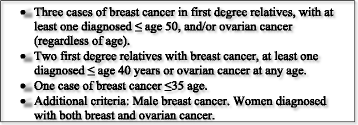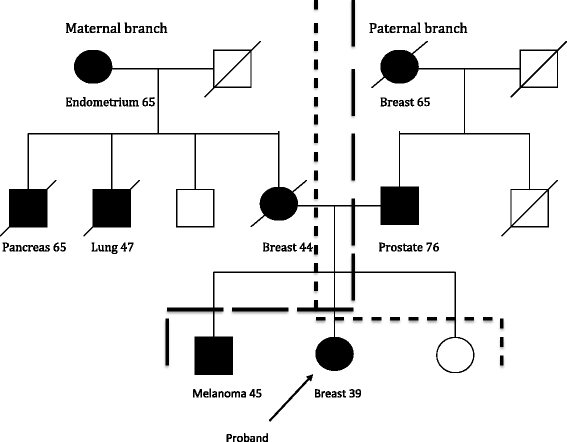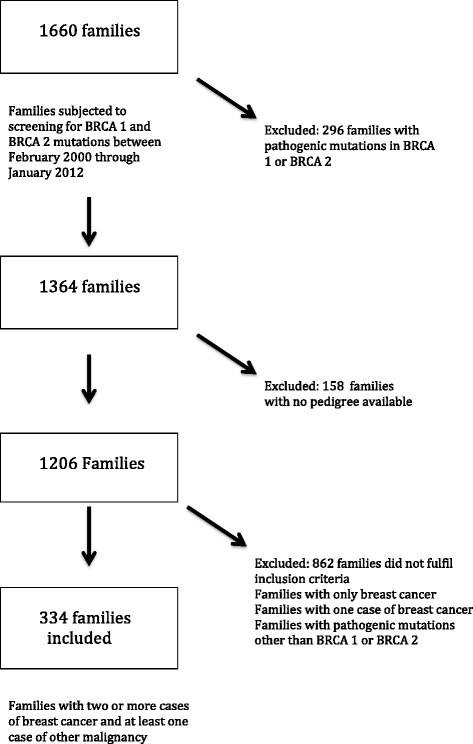Tumour spectrum in non-BRCA hereditary breast cancer families in Sweden
- PMID: 26082817
- PMCID: PMC4469256
- DOI: 10.1186/s13053-015-0036-z
Tumour spectrum in non-BRCA hereditary breast cancer families in Sweden
Abstract
Background: Approximately 30 % of all breast cancer is at least partly attributed to hereditary factors. Familial breast cancer is often inherited in the context of cancer syndromes. The most commonly mutated genes are BRCA1 and BRCA2 in hereditary breast and ovarian cancer syndrome. The genetic background in families with hereditary breast cancer without predisposing germ line mutations in BRCA1 and BRCA2 (non-BRCA families) is still to a large extent unclear even though progress has been made. The aim of this study was to compare cancer proportions in familial non-BRCA hereditary breast cancer compared to the general population in search of putative new breast cancer syndromes.
Methods: Pedigrees from 334 non-BRCA hereditary breast cancer families in the county of Stockholm, Sweden, were investigated and the distribution of cancer diagnoses other than breast cancer was compared with the distribution of cancer diagnoses in the general Swedish population in two reference years, 1970 and 2010. A cancer diagnosis was regarded as overrepresented in the non-BRCA families if the confidence interval was above both population reference values.
Results: We found that endometrial cancer was overrepresented in the non-BRCA families with a 6.36 % proportion (CI 4.67-8.2) compared to the proportion in the general population in the reference years 1970 (3.07 %) and 2010 (2.64 %). Moreover tumours of the ovary, liver, pancreas and prostate were overrepresented.
Conclusion: In conclusion, we found an overrepresentation of endometrial cancer in our cohort of hereditary non-BRCA families. Our result supports previous inconsistent reports of a putative breast and endometrial cancer syndrome. An association has been suggested in studies of families with several cases of breast cancer in close relatives or bilateral breast cancer. To clarify this issue we suggest further studies on a breast and endometrial cancer syndrome in cohorts with a strong pattern of hereditary breast cancer. Identifying new breast cancer syndromes is of importance to improve genetic counselling for women at risk and a first step towards detection of new susceptibility genes.
Keywords: Breast cancer; Cancer syndrome; Endometrial cancer; Family history.
Figures



Comment in
-
A breast and endometrial cancer syndrome.Maturitas. 2016 May;87:3-4. doi: 10.1016/j.maturitas.2016.01.011. Epub 2016 Jan 22. Maturitas. 2016. PMID: 27013282 No abstract available.
References
-
- Ferlay JSH, Bray F, Forman D, Mathers C, Parkin DM. Breast cancer (C50), World age-standardised incidence and mortality rates, females, regions of the world, 2008 estimates (Cancer Research UK) GLOBOCAN 2008 v12, Cancer Incidence and Mortality Worldwide: IARC CancerBase No 10 [Internet].
-
- Cancer incidence in Sweden 2010 (socialstyrelsen).
-
- Collaborative Group on Hormonal Factors in Breast Cancer Familial breast cancer: collaborative reanalysis of individual data from 52 epidemiological studies including 58,209 women with breast cancer and 101,986 women without the disease. Lancet. 2001;358(9291):1389–99. doi: 10.1016/S0140-6736(01)06524-2. - DOI - PubMed
LinkOut - more resources
Full Text Sources
Other Literature Sources
Miscellaneous

